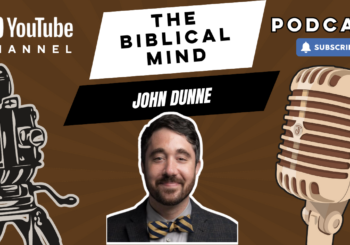Part of the Purifying Ourselves: Moral Formation in the Bible series
Fire, Soap, and Knives: The Book of Proverbs as a Means to Virtue
You have probably seen a version of this commercial. The first one I watched shows a man take a bite from an apple. In the next scene he takes a large bite from a bar of soap. Hats off to the actor willing to communicate the message so viscerally: Uber Eats delivers more than just food.
Proverbs 23:2 has a short line that says, “Put a knife to your throat if you’re mastered by your appetite.”
Enjoying this article? Read more from The Biblical Mind.
The proverb works in the same manner as the Uber Eats commercial. We don’t have to eat soap to learn something about Uber Eats shipping, and we don’t have to threaten ourselves with violence to develop self-control. In both examples, the creative mixture of ideas, desires, and emotions transforms us through our imagination.
This is not the only proverb of this kind. In fact, contrary to common misconceptions, Proverbs is far from just a list of practical rules for life: “Do this.” “Don’t do that.” Rather, as we will see here, Proverbs is a brilliant collage of sayings that shape our reason, desires, and emotions for moral action.
To appreciate how this works we need to look briefly at the concept of virtue and its place in moral psychology before turning to observe some proverbs in action.
Virtue and Imagination in Proverbs
Let’s begin by returning to the proverb quoted above in its fuller context.
When you sit at the table of a ruler,
consider carefully what is before you,
and put a knife to your throat
if you are mastered by appetite.
Do not desire his delicacies,
for it is food that lies. (Prov 23:1–3)
This cluster of sayings pauses us at a ruler’s feast, taking in the full breadth of his possessions: food, wine, wealth, social connections, servants, and the like. The surplus of his luxury naturally awakens our desire for things we don’t have. Just then we are told to put a knife to our throat, remembering that desire often leads us astray.
Quite a bit more is going on in behavior formation than meets the eye.
To start, most ancient Israelites were subsistence farmers and few, if any, would ever have dined with a ruler. The proverb is not, therefore, addressing a common occurrence, but using our imagination to provoke desire.
Which leads us to notice how proverbs work through a sophisticated combination of concepts and metaphors. Our short saying has distinct words for reason (“consider carefully”), worldly goods (“what is before you”), pain (“a knife”), and desire (“appetite”). This coordination of reason, objects, emotion, and desire in moral instruction is at the heart of what we call “character” or “virtue ethics.”1For those interested in specifics, virtue also involves (1) orientation to good “purposes” or “ends” and (2) habituation of virtuous behaviors. Proverbs develops virtue through our imagination.
Said otherwise, the proverb above doesn’t really want us to have knives on hand to threaten self-harm when we are tempted. Rather, shocking images like knives, fire, blood, and dog bites provoke intense emotional responses alongside strong desires for food, wealth, pleasure, and power. The violent images stop us in the moment, inviting us to evaluate our inclinations against the teaching of a proverb.
When studied over time, proverbs such as this one order our knowledge, emotions, and desires toward wise and righteous actions.
But can these little ancient sayings in Proverbs really do all that? Yes, but to demonstrate how, we need to take a short journey into virtue theory within contemporary moral psychology.
Virtue in Moral Psychology
I assume we all recognize that moral rules on their own only go so far in helping us act rightly. The apostle Paul laments this problem in Romans 7: he knows the right thing to do but still does the opposite. Moral action is more than “knowing.” In fact, research over the last 30 years has increasingly shown that moral action requires a complex coordination of desire, reason, and emotion—basically what ethicists call “virtue.”2For a good overview see James A. Van Slyke, “Moral Psychology, Neuroscience, and Virtue” in Virtues and Their Vices, ed. Kevin Timpe and Craig A. Boyd (Oxford: Oxford University Press, 2014), 459–80.
Proverbs has the power to help develop virtue through its character portraits and metaphors like the knife at the throat discussed above.
These characters and metaphors work by eliciting empathy, or imitation. Think about the way babies learn to smile, laugh, wave, and do countless other things by imitating our actions. Their bodies are hard-wired for “empathic reflex”: they mimic what they see others doing around them apart from any conscious effort. Scientifically speaking, the baby’s mind-body is responding to our mind-body deep within a complex neural network of reason, emotion, and muscles.
This process does not stop as we grow into adulthood. In fact, cognitive scientists can measure the degree to which our adult minds, bodies, and emotions imitate or emulate not only people, but also metaphors, stories, and concepts. For example, when I think about a headache, my body naturally reproduces most of the experience of having a headache (even though I may not actually sense the pain).3Elena Semino, “Descriptions of Pain, Metaphor, and Embodied Simulation,” in Metaphor and Symbol 25 (2010) 205–26.
Think about the last time you cried, laughed, or became angry watching a fictional movie or reading a book. You were experiencing this same process of empathy and imitation even though you knew the story was fictional. Or in the case of the knife in the proverb, we know it’s not literal, but, like the story, the image still affects us.
You might already sense that proverbs are basically like parables. They arrest us with powerful examples from the world that prompt us to moral deliberation. In this way, proverbs and parables function much as our smiles do for a baby watching and mirroring us.
Our memory also plays a role in this process. When we re-read or rehear these character portraits and metaphors about pain, pleasure, or fear, our responses grow stronger over time.4Ellen Swannell et al., “Some Words Hurt More Than Others: Semantic Activation of Pain Concepts in Memory and Subsequent Experiences of Pain,” Journal of Pain 17.3 (2016) 336–49. Which is to say that the habit of reading proverbs strengthens our cognitive and emotional responses into habits of action.
Mind-Body Virtue in Proverbs
Let’s look at three examples of virtue formation in Proverbs.
1. The Desires of our Hearts
Proverbs 4:23 reads, “More than anything else, watch your heart, for from it are the sources of life.” The “heart” in biblical Hebrew is the source of all reason and desire. Nothing in the search for wisdom is more important than aiming the knowing and desiring heart at the right ends.
Proverbs points us toward these ends with the metaphor of erotic love. Note that over half of the verses in Proverbs chapters 1–9 mention sexual desire.
Drink water from your own cistern,
flowing waters from your own well. (5:15)May your fountain be blessed,
and rejoice in the wife of your youth, (5:18)a lovely deer, a graceful doe.
May her breasts satisfy you at all times,
and may you be always intoxicated in her love (5:19)Why, my son, are you intoxicated with a strange woman,
and embrace the bosom of a foreigner? (5:20)Say to wisdom, “You are my sister;”
call to understanding “Friend.”
To keep you from the foreign woman,
from the stranger’s smooth words. (7:4–5)
None of the wisdom traditions in ancient Egypt and Mesopotamia shared anything like this exceptional focus on sexual desire as in Israel’s wisdom literature.5Roland Murphy, “Wisdom and Eros in Proverbs 1–9,” Catholic Biblical Quarterly 50 (1988), 600–603. More importantly, Proverbs constantly sets sexual desire alongside the desire for wisdom or folly as in 7:4–5 above.
In sum, as Proverbs stirs up our desire for sex, it simultaneously elicits a strong response in the complex machinery of our embodied mind. Proverbs then steers that energy away from the impulse for immediate pleasure towards a patient desire for wisdom, virtue, and life:
Those who love me, I love,
and those who seek me longingly, find me. (8:17)
Modern readers might be embarrassed by associating sexual yearnings with a desire for God and the good life. Proverbs obviously has no such reservations.6Erotic desire for God and wisdom in scripture is common, e.g. Song of Songs, Hosea, and John 4:1–30. Origen of Alexandria and Gregory of Nyssa represent a longstanding tradition that associates eros with desire for God. Wisdom will only be found by those who learn to search for her like an erotic lover.
2. Pain and Pleasure
Whereas Proverbs chapters 1–9 chiefly aim to channel our desires and pleasures into the search for wisdom, chapters 20–26 link wickedness and folly with emotions of fear, disgust, and pain.
There are actually more sayings expressing pain, disgust, and danger in Proverbs than those that imagine pleasure. The Nobel laureate psychologist Daniel Kahneman observes that our minds process bad news faster than good news. Even single words like “war” and “crime” process faster than “peace” and “love.”7Daniel Kahneman, Thinking, Fast and Slow (New York: Farrar, Straus and Giroux, 2013), 301. As such, the discomfort in Proverbs is more powerful than pleasure in eliciting an immediate emotional response.
The writers of Proverbs had an intuitive sense of this, as seen in their use of pain and danger in their sayings.8See Ryan P. O’Dowd, “Pain and Danger: Unpleasant Sayings and the Structure of Proverbs,” Catholic Biblical Quarterly, 80 (2018) 619–35. Just consider the creative images woven into their moral lessons: a flame held to the bosom, bare feet on smoldering coals, hot smoke rising in the eyes, vomiting, vinegar poured on an open wound, a serpent’s bite, a broken bone, eyes plucked out by ravens, a nose twisted until it bleeds, and more.
Yes, ouch! The creativity in these sayings is often remarkable. Consider how the following proverb contrasts the momentary pleasures of deception against the pains of its eventual consequences.
Sweet to a man is bread of deceit,
but afterwards his mouth is full of gravel. (20:17)
Stop and imagine chewing on small rocks for a minute while contemplating lying. Not pleasant, right? A single reading of the saying gives a jolt. Yet, as we have seen from research in moral psychology, the repetition of the proverb leads the mind to intensify the association of rocks in the mouth with pain and deceit. This can aid the habituation of truthfulness.
Here are two examples from chapter 26 worth a closer look:
A thorn goes up into the hand of a drunkard;
so is a proverb in the mouth of a fool. (26:9)Like a maniac who shoots firebrands arrows and death,
is the man who deceives his neighbor,
and says, “I was only joking.” (26:18–19)
Wincing pain and recklessly lethal behavior. I trust we can appreciate that the danger and pain in these verses are exaggerated for effect, which is often the case. These ancient proverbialists stumbled upon a rhetorical method that, as we know from moral psychology, has a sophisticated effect on the ordering our reason, emotion, and desire, which promotes virtue.
3. Exemplary Models
A final way Proverbs shapes our moral imagination is through exemplary characters. Moral exemplars employ our instincts for imitation, or empathy, to orient us toward good moral purposes and actions. The exemplar is not merely someone who can make wise decisions, but also one for whom training in virtue becomes intuitive—someone who no longer needs to wrestle with each individual moral discernment.9Van Slyke, “Moral Psychology, Neuroscience and Virtue,” 459–67. Think of Joseph who did not have a long, internal struggle when tempted by Potiphar’s wife. He just ran. That is exemplary virtue.
Such exemplary models go beyond the individual sayings in the way they involve us emotionally and cognitively in the lives of the fictional characters before us.10On the power of literary characters see Maryanne Wolf, Reader, Come Home: The Reading Brain in a Digital World (New York: Harper, 2018), 42–53.
Proverbs chapters 1–9 combine three sets of characters: the good wife and Lady Wisdom, the wise mother and father, and the wise and righteous child.11For a great overview of Prov 1-9 see William P. Brown, Character in Crisis: A Fresh Approach to the Wisdom Literature of the Old Testament (Grand Rapids: Eerdmans, 1996), 30–49. These characters are united by their opposition to Dame Folly, the adulteress, the sinner, the wicked, and the fool, who repeatedly fall into their own traps:
But they lie in wait for their own blood,
and ambush their own lives. (1:18)
Thus, as the wicked and foolish person approaches inevitable death (9:18), the wise and righteous live, walk on safe paths, gain favor, receive a blessing, and obtain the tree of life. Their moral lives are also characterized by discretion, honesty, justice, humility, wise speech, generosity, and diligence.
Perhaps the most memorable exemplary character in the OT/HB is the valiant woman of chapter 31:10–31. Rather than seeing her simply as a picture of a good wife, we should regard her as an affirmation of the fullness of human vocations in this world. Our desire for her leads us (men and women) to imitate her life in our own calling (31:10).
Perhaps no other biblical character offers such a well-rounded picture of virtue. She works with immense diligence and vision (vv. 13, 19, 22, 24, 27, 31); she is generous and compassionate (vv. 15, 20, 26), courageous and hopeful (vv. 13, 17, 21, 25), and modest and humble (v. 30). In the short space of a poem we witness her expertly ordering her emotions, desires, and actions toward the flourishing of her family and her community.
At the end of the book, the valiant woman perfectly depicts what Proverbs aims to accomplish with its nearly one thousand sayings: people who are so trained in wisdom that they know the good, love the good, choose the good, and act upon the good. Such is the power of knives, soap, and fire. And, yes, love.
End Notes
1. For those interested in specifics, virtue also involves (1) orientation to good “purposes” or “ends” and (2) habituation of virtuous behaviors.
2. For a good overview see James A. Van Slyke, “Moral Psychology, Neuroscience, and Virtue” in Virtues and Their Vices, ed. Kevin Timpe and Craig A. Boyd (Oxford: Oxford University Press, 2014), 459–80.
3. Elena Semino, “Descriptions of Pain, Metaphor, and Embodied Simulation,” in Metaphor and Symbol 25 (2010) 205–26.
4. Ellen Swannell et al., “Some Words Hurt More Than Others: Semantic Activation of Pain Concepts in Memory and Subsequent Experiences of Pain,” Journal of Pain 17.3 (2016) 336–49.
5. Roland Murphy, “Wisdom and Eros in Proverbs 1–9,” Catholic Biblical Quarterly 50 (1988), 600–603.
6. Erotic desire for God and wisdom in scripture is common, e.g. Song of Songs, Hosea, and John 4:1–30. Origen of Alexandria and Gregory of Nyssa represent a longstanding tradition that associates eros with desire for God.
7. Daniel Kahneman, Thinking, Fast and Slow (New York: Farrar, Straus and Giroux, 2013), 301.
8. See Ryan P. O’Dowd, “Pain and Danger: Unpleasant Sayings and the Structure of Proverbs,” Catholic Biblical Quarterly, 80 (2018) 619–35.
9. Van Slyke, “Moral Psychology, Neuroscience and Virtue,” 459–67.
10. On the power of literary characters see Maryanne Wolf, Reader, Come Home: The Reading Brain in a Digital World (New York: Harper, 2018), 42–53.
11. For a great overview of Prov 1-9 see William P. Brown, Character in Crisis: A Fresh Approach to the Wisdom Literature of the Old Testament (Grand Rapids: Eerdmans, 1996), 30–49.
Image created by Rubner Durais
Did you enjoy this article? Check out The Biblical Mind podcast.





